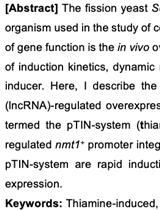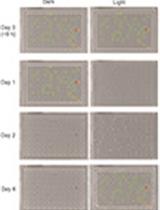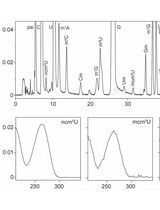- EN - English
- CN - 中文
Candida albicans Culture, Cell Harvesting, and Total RNA Extraction
白念珠菌培养、细胞收获和总RNA提取
发布: 2020年11月05日第10卷第21期 DOI: 10.21769/BioProtoc.3803 浏览次数: 5027
评审: Kristin L. ShinglerJorge AmichAnonymous reviewer(s)
Abstract
Transcriptional analysis has become a cornerstone of biological research, and with the advent of cheaper and more efficient sequencing technology over the last decade, there exists a need for high-yield and efficient RNA extraction techniques. Fungi such as the human pathogen Candida albicans present a unique obstacle to RNA purification in the form of the tough cell wall made up of many different components such as chitin that are resistant to many common mammalian or bacterial cell lysis methods. Typical in vitro C. albicans cell harvesting methods can be time consuming and expensive if many samples are being processed with multiple opportunities for product loss or sample variation. Harvesting cells via vacuum filtration rather than centrifugation cuts down on time before the cells are frozen and therefore the available time for the RNA expression profile to change. Vacuum filtration is preferred for C. albicans for two main reasons: cell lysis is faster on non-pelleted cells due to increased exposed surface area, and filamentous cells are difficult to pellet in the first place unlike yeast or bacterial cells. Using mechanical cell lysis, by way of zirconia/silica beads, cuts down on time for processing as well as overall cost compared to enzymatic treatments. Overall, this method is a fast, efficient, and high-yield way to extract total RNA from in vitro cultures of C. albicans.
Keywords: Candida albicans (白念珠菌)Background
The need for fast, reproducible, and efficient RNA extraction techniques has grown significantly over the last several years due to the steady increase in use of RNA sequencing and other expression analysis techniques that have become more affordable and faster with improvements in sequencing technology. There are many different kits and protocols out there from various companies and labs that attempt to meet this need. However, methods that are built specifically for one type of fungi may not be usable for another, and kit platforms can often fall short by way of being too broad in their application. Here we describe a cell culture, harvest, and RNA extraction method for the pathogenic fungus, Candida albicans, that utilizes a combination of techniques to give both high yield and high-quality RNA in a consistent and efficient manner.
One of the main attributes unique to this approach is the harvest of cells via vacuum filtration rather than by centrifugation. Centrifugation of a 25 ml culture of filamentous cells, as is used in this protocol, must be done over a period of 5 min in order to pellet the cells enough to aspirate the growth media. This additional time before freezing the cells and halting cellular processes opens the door for unwanted transcriptional changes. Previous studies have shown that yeast cells can alter their expression profiles well within the 5 min that is needed to spin cells down (Dikicioglu et al., 2011). It is then of critical importance to shorten the time between the incubation/growth period and when the cells are frozen, and vacuum filtration serves this purpose well. It can take anywhere from 5-10 min between incubation and freezing when using centrifugation, but that time decreases to 1-2 min using vacuum filtration with the most time-consuming step being transporting the samples from the bench to the freezer. Not only does this saved time cut down on transcriptional variation, but it also allows for more samples to be processed in the same amount of time increasing overall throughput for this method.
The second variation in this this approach that differs from other methods is the use of zirconia/silica beads in combination with a lysis buffer for cell disruption as opposed to enzymatic or lysis buffer only methods. Mechanical cell disruption via bead beating has been shown to significantly increase RNA yields in C. albicans, compared to vertical vortexing without beads in lysis buffer alone (Rodríguez and Vaneechoutte, 2019). Zirconia/silica beads have a higher density than the typical glass beads used in bacterial (3.7 g/cm3 and 2.5 g/cm3 respectively) which increases their efficiency at rupturing the tough fungal cell walls. An additional benefit of mechanical cell disruption is that enzymatic methods such as zymolyase digestion have been shown previously to alter RNA expression profiles of the sample being assayed by activating stress response pathways thereby confounding the downstream analysis (Suzuki and Iwahashi, 2013).
Overall, by utilizing mechanical cell disruption and vacuum filtration combined with the commercially available Qiagen RNEasy MiniKit, this technique represents a fast, and efficient method for cell harvesting and RNA extraction saving time and giving more consistent and reliable transcriptional data.
Materials and Reagents
15 ml polypropylene culture tubes (VWR, catalog number: 82050-274 , item #187262)
Note: Can be from any source.
25 ml serological pipettes (VWR, catalog number: 89130-912 )
Note: Can be from any source.
50 ml conical screw cap tube (Fisher Scientific, catalog number: 0553913)
Note: Can be from any source.
1.5 ml screw cap tubes (Fisher Scientific, catalog number: 1415-8700 )
Note: Can be from any source.
RNase-free 1.5 ml microcentrifuge tubes (Fisher Scientific, catalog number: 14-666-319 )
Note: Can be from any source.
250 ml 0.1 µm PES membrane vacuum filtration unit (Fisher Scientific, catalog number: 09741201)
Note: Can be from any source.
Cuvettes PS Semi-micro (VWR, catalog number 9700-586 )
Note: This is dependent upon the method of measuring the OD600 of cell cultures to be used.
Uvette 220-1600 nm (Eppendorf, catalog number: 952010051 )
Note: This is dependent upon the method of quantifying purified RNA.
0.5 mm zirconia/silica disruption beads (Research Products International, catalog number: 9834 )
Follow manufacturer instructions to sterilize and eliminate nucleic acid contamination and store at -20 °C
MF-MilliporeTM 0.45 µm, 47 mm diameter gridded filter membrane (Merk Millipore Ltd., MF-MilliporeTM, catalog number: HAWG04700 )
Relevant C. albicans strains (SC5314 and an SC5314 derived efg1Δ::HIS1 mutant strain constructed by the authors were used in this example)
Yeast extract (BD, BactoTM, catalog number: 212750 )
Peptone (BD, BactoTM, catalog number: 211677 )
Dextrose (Sigma Life Science, catalog number: D9434-1KG )
RPMI 1640 (Sigma-Aldrich, catalog number: R4130-10L ), store at 4 °C
Fetal Bovine Serum Premium (Atlanta Biologicals, R&D Systems, catalog number: S11150H ), store at -20 °C
Phenol:chloroform:isoamyl alcohol (Sigma Life Science, catalog number: 77617-100ml ), store at 4 °C
Qiagen RNEasy Mini Kit (Qiagen, catalog number: 74104 )
NaOH salt (Sigma-Aldrich, catalog number: 221465-500G )
Note: Can be from any source.
100% pure Ethanol (Sigma-Aldrich, catalog number: E7023-1L )
Note: Can be from any source.
Deionized H2O (any source)
β-mercaptoethanol (Sigma-Aldrich, catalog number: 444203-250mL )
Note: Can be from any source.
YPD liquid growth media (see Recipes)
10 N NaOH (see Recipes)
RPMI + 10% FBS (see Recipes)
Equipment
Glass 125 ml Erlenmeyer flasks (Fisher Scientific, catalog number: FB501125 )
Note: Can be from any source.
30 °C incubator (any source)
Rotator drum for overnight cultures (New Brunswick Scientific, model: TC-7 , catalog number: M1053-4004)
Note: This is out of production but can be substituted for a similar rotator that can reach 60-70 rpm.
Eppendorf BioPhotometer® D30 (Eppendorf, catalog number: 6133000010 )
Note: This can be substituted for another spectrophotometer with similar capabilities.
Shaking incubator 37 °C (New Brunswick Scientific, Eppendorf, model: I-26, catalog number: M1324-0000)
Note: This can be substituted for another shaking incubator with similar capabilities.
Microcentrifuge (Thermo Scientific, model: Sorvall Legend Micro 21, catalog number: 75002436)
Note: This can be substituted for another microcentrifuge that can spin at ≥ 17,000 x g.
1-2 L sidearm Erlenmeyer flask (any source)
MiniBeadBeater-16 (BioSpec Products, model: 607 )
Note: The authors have not attempted this protocol with another type of bead beater, however a similar horizontal bead beater with similar specifications would most likely yield similar results.
Millipore 47 mm glass base and stopper (Millipore, catalog number: XX1014702 )
50 ml conical tube rack (any source)
-80 °C and -20 °C freezer (any source)
4 °C refrigerator or cold room (any source)
Standard benchtop vortexer (any source)
Forceps
Procedure
文章信息
版权信息
© 2020 The Authors; exclusive licensee Bio-protocol LLC.
如何引用
Cravener, M. V. and Mitchell, A. P. (2020). Candida albicans Culture, Cell Harvesting, and Total RNA Extraction. Bio-protocol 10(21): e3803. DOI: 10.21769/BioProtoc.3803.
分类
微生物学 > 微生物遗传学 > 基因表达
微生物学 > 微生物信号传导 > 感知受体
分子生物学 > RNA > RNA 提取
您对这篇实验方法有问题吗?
在此处发布您的问题,我们将邀请本文作者来回答。同时,我们会将您的问题发布到Bio-protocol Exchange,以便寻求社区成员的帮助。
Share
Bluesky
X
Copy link













